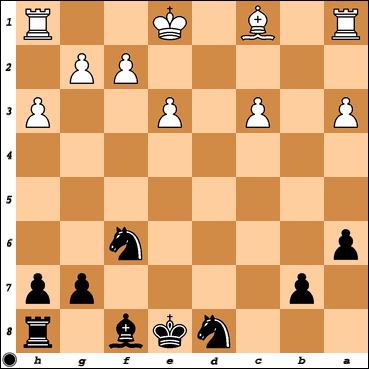Okay, I've given it a while so let's end the speculation and answer the questions we set earlier!
Firstly, nobody came close to guessing the opening.

This I didn't expect though to be fair, the whole thing went mad so it was very difficult. The game was a 3 minutes + 0 blitz game on Chesscube against someone with a tournaments blitz rating of 1856. The opening was a totally normal exchange Slav.
So, of course a3 and h3 are perfectly silly moves by White, but his errors aren't in focus here and I can't be blamed for seizing my chances.
I showed this position and how it arose to George, our many times club champion, who at the age of 71 is still getting stronger and playing to a good 150 odd standard at least, and higher in some positions. He felt that the ...Rxc3! move was natural and strong, and that in the stem position we discussed, Black is ahead. Initially I had my doubts about whether he can be ahead; per se - let's just say Black has some initiative. This feels like the sort of position where you'd find a huge struggle between two level players of 2
x00 up to a certain level of mastery grandmasteriness, after which there'd probably be some total pure sequence of technique that shows an answer to who really is better.
First, let me publish my verbal analysis of the position, so that people may correct my thoughts.
Black will try to storm the weaknesses of White's position with rampant minor pieces. But my intuition is that this isn't quite sufficient and that I could outplay myself as White.
White wants to make space for his Bishop to keep mine under check, and let both Rooks combine to probe for targets. Effectively White will want to get enough space to push forward.
Imbalances:
White has a 4-2 pawn majority Kingside. He has an isolated couple of a-c pawns however, in comparison to Black's healthy pair on b7/a6, albeit the b-pawn is temporarily backward.
Materially, Black has a pair of Knights, for a Rook and two pawns. If Black could mortally lock his Knights into the heart of the White position, such as on c5/d3, this would have two effects:
1. It blocks the d-file, making it harder for White to use his Rooks,
2. It creates some negative space to harass the White Bishop.
If we can harass the Bishop and make our own a relatively better Bishop, we have a superior minor piece and a good Bishop.
There are open files for White on the d/b-file, the latter having a juicy pawn target. Meanwhile Black has a semi c-file to work down, and could potentially position himself against the happy e/f-pawn.
Space is a hard one to quantify here. Currently, White doesn't quite have enough space from his skeleton, but because of the dearth of pieces, White will hope to be able to shove a few pawns forward.
By definition white has a better pawn structure because of the supermajority on the Kingside, so his aim should be to use it effectively.
As for control of key diagonals, it's reasonably clear that both sides want a1-h8 for their own, so that's in flux.
Neither side could really be said to have the initiative I think.
So it's fair to say White is fine, but the whole thing is quite tense.
I think I would only really revise the point about initiative, retrospectively having subjected this position to some analysis here.
When analysing, I immediately had the thought that since Black has the minor pieces he should be aggressive, so in popped
1...Ne4. I later looked at
1...Bd6 and
1...Ne6, and George wanted to play
1...Nc6 (I asked him before you guys) and I have to say that since we have Ne6 available I find it difficult to see how someone would want to play that. He gave no explanation as to what he saw in it over Ne6.
I think
1...Ne4 is perfectly good. George criticised this, as if I was playing with one piece. I had to forcefully remind him this was not my intent, but he still preferred my other choices. Houdini approves but curiously wants to play Bd2 or f3 or Ra2, approving these with Bb2 as White.
I meanwhile analysed among the following lines. I haven't posted everything since it's a very open game, the sort where 2400s will probably blitz a load of sequential moves out but below that, it could be a case of taking a few minutes on every move.
1...Ne4 2. Bb2 Bd6 3. Rd1 0-0 4. 0-0 Be5 5. f3 Ng3
(5...Bxc3? 6. fxe4! Ba5 is nasty) with a very tense game.
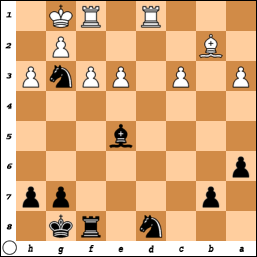
George wanted to play 3. Rf1!? which is very unlike him! 3...0-0 4. 0-0-0 and Black has an easier time of attacking White's weak points.
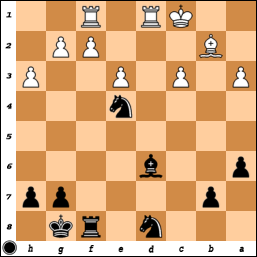
If White tries a positional approach with 2. a4, g6 seems to work. 2. a4 Nxc3 3. Ba3 on the other hand would be a happy pawn sacrifice for White, removing the active Bishop in time, since it strikes me in general that Black will have his hardest days ahead in a Rooks v Knights endgame, since 2 Knights are often a duplication of function, and with an asymmetrical pawn structure, White wants to keep his duplicate Rooks.
He can try to sac the pawn in a more developmental style too: 2. 0-0 Nxc3 3. Bb2 Na4 4. Rfb1 b5 isn't enough compensation though.
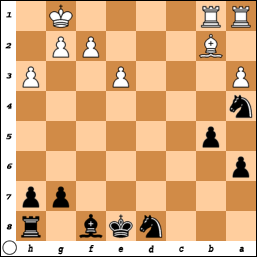
Meanwhile 2. c4 Nc5 seems very nice, since the twin threats of Nb3/xc1 followed by Bxa3, and Nd3+ giving Black a firm grip. If White tries to override this with 2. Rb1 he isn't paying attention to the position, which demands he occupy the d-file. 2. Rb1 Bd6 and he has just lost time.
In the game I played artificially as you do in a blitz with
1...b5 which doesn't in itself do anything to set the evaluation of the position in stone - how can we possibly petrify the statics of such an imbalance? White is probably ahead because he can open files for those frothy Rooks, but he played very badly and was smashed.
If White wanted to kick me for my error, 1...b5 should be followed the thematic shattering move 2. a4!, forcing open a new file for the Rook. 2...b4 3. cxb4 Bxb4+ 4. Bd2 and Black has less compensation for his material now.
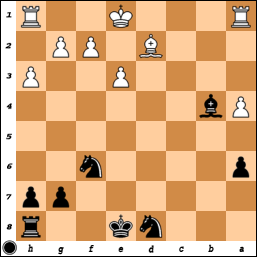
Black also has the option of using the second Knight here: 1...Ne6 2. c4 Nc5 3. Ke2!? and now one of our club's stronger players (who is the total opposite style to George) wanted to play 3...a5 so that if 4. Rb1, a4!?, which is about as pure a sequence as you could come up with outside of asking an engine. I frankly view his suggestion with positional suspicion since it strikes me that a single Knight on b3 isn't worth enough to justify this buildup.
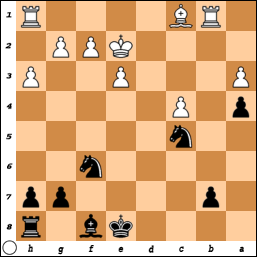
The odd thing however was that George all night while we discussed, had been pooh-poohing Rb1 as a concept, yet here, suggested after my 1...Ne6 2. c4 Nc5 3. Ke2!? g6, 4. Rb1. We then tried 4...Bg7 5. a4 0-0 6. Ba3 Rc8 7. f3
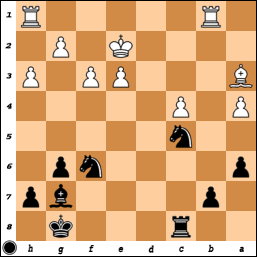
(since
7. Bxc5 Rxc5 8. Rfc1 Rc7 leaves Black comfortable with obvious pressure) and again it's unclear what's happening but as many of you have said, Black is happier of the two for now.
Admittedly I haven't looked at the following as I did the former, but George suggested that play could continue 1...Nc6 2. f3 Bc5 but I guess it's a case of him looking for the solidest configuration for Black, since he's very much a statics based player.
In summation, Houdini 1.5a just prefers 1...Ne4, but equally thinks that Bc5 is viable. It doesn't rank Ne6 or Bd6 though, and this wasn't a particularly deep search. Certainly this is the sort of position where there is no one answer, but where certain styles will lend themselves to having an easier time.
